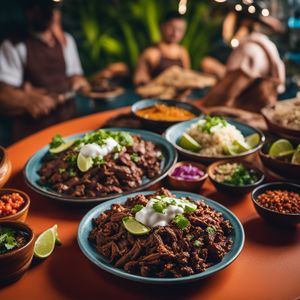
Dish
Ahima’a
Ahima'a
The dish is made by wrapping meat, usually pork or chicken, in banana leaves and placing it in the umu with hot rocks. The meat is then covered with more banana leaves and left to cook for several hours. The result is a tender and flavorful meat that is infused with the smoky flavor of the banana leaves and the earthy flavor of the umu. Ahima’a is often served with taro, breadfruit, and coconut cream.
Origins and history
Ahima’a has been a part of Polynesian culture for centuries. It is believed to have originated in Samoa and spread throughout the Pacific islands. The dish is often associated with special occasions and is a symbol of hospitality and generosity. In some Polynesian cultures, the umu is considered sacred and is only used for important events.
Dietary considerations
Ahima’a is a gluten-free and dairy-free dish that is suitable for people with celiac disease and lactose intolerance. However, it is high in fat and calories, so it should be consumed in moderation by people who are watching their weight or have high cholesterol levels.
Variations
There are many variations of ahima’a that use different types of meat and vegetables. Some versions of the dish use fish or seafood instead of meat. In Hawaii, ahima’a is often made with kalua pig, which is a type of smoked pork. In Samoa, the dish is called umu and is made with taro, yams, and breadfruit.
Presentation and garnishing
Ahima’a is usually presented on a large platter with the meat in the center and the side dishes arranged around it. The banana leaves are often left on the meat to add to the presentation. The dish can be garnished with fresh herbs such as cilantro or parsley.
Tips & Tricks
To make ahima’a, it is important to use high-quality meat and fresh banana leaves. The umu should be heated to the right temperature and the meat should be wrapped tightly in the banana leaves to prevent it from drying out. It is also important to let the meat rest for a few minutes before serving to allow the juices to redistribute.
Side-dishes
Ahima’a is often served with taro, breadfruit, and coconut cream. These side dishes complement the smoky and earthy flavors of the meat and add texture and variety to the meal.
Drink pairings
Ahima’a is traditionally served with kava, which is a Polynesian drink made from the root of the kava plant. Kava has a relaxing effect and is often used in social gatherings and ceremonies. However, it can have a sedative effect and should be consumed in moderation.
Delicious Ahima’a recipes
More dishes from this category... Browse all »

Agemono
Japanese cuisine

Al dente
Italian cuisine

Alla creta
Italian cuisine

Asador criollo
Argentinian cuisine

Baoshao
Chinese cuisine

Barbacoa
Mexican cuisine

Barbecue
American cuisine

Binagoongan
Filipino cuisine


